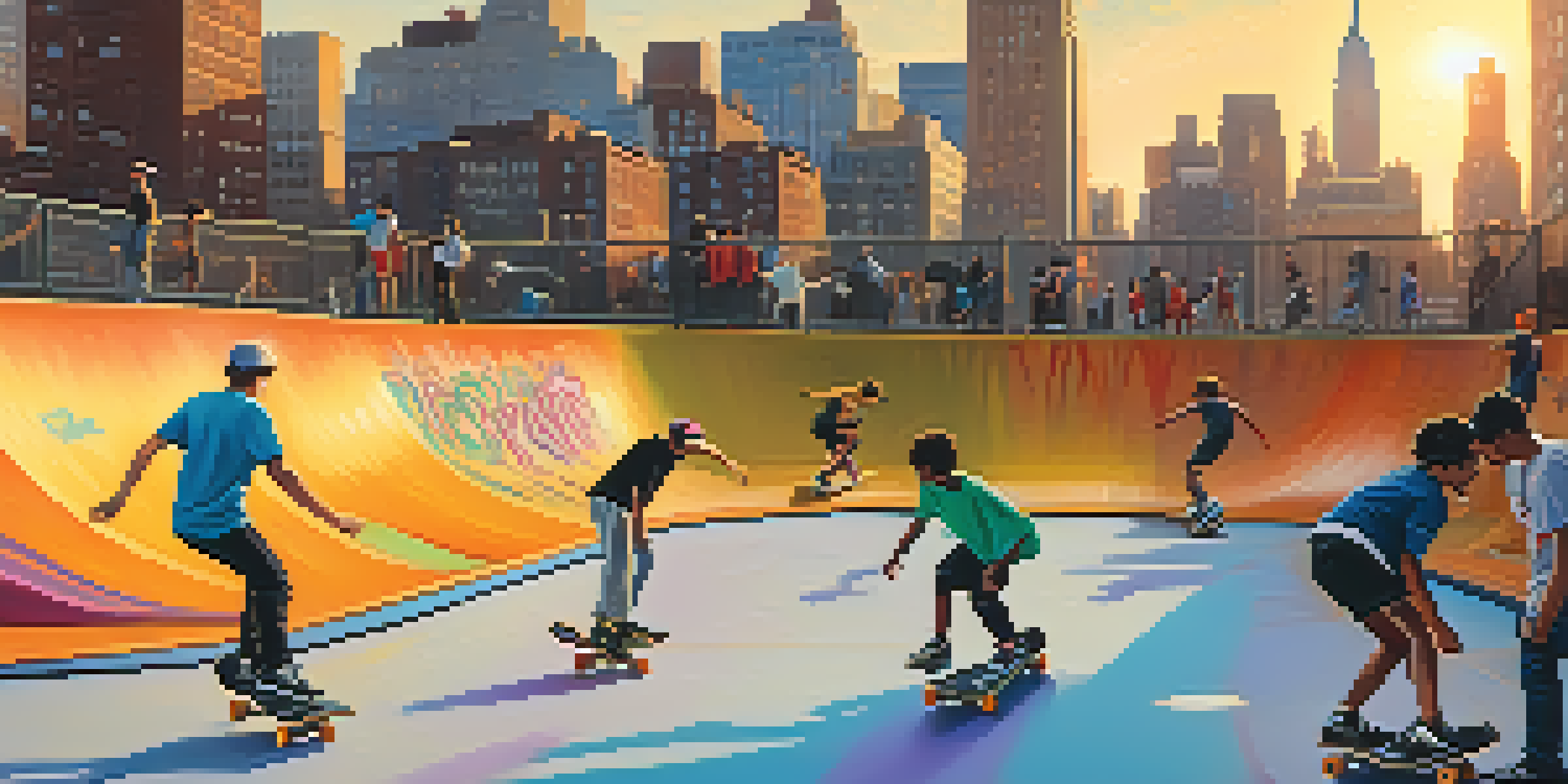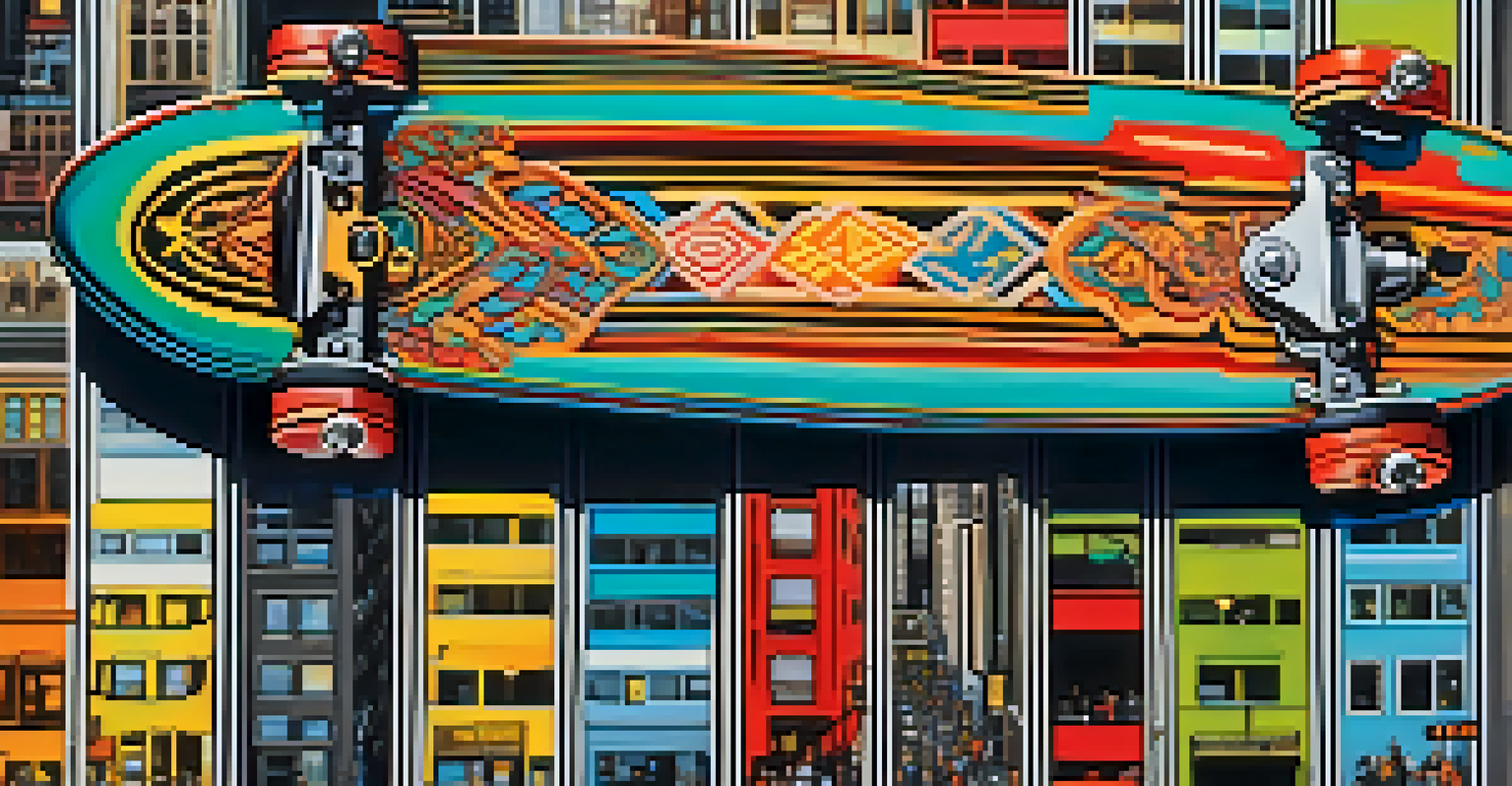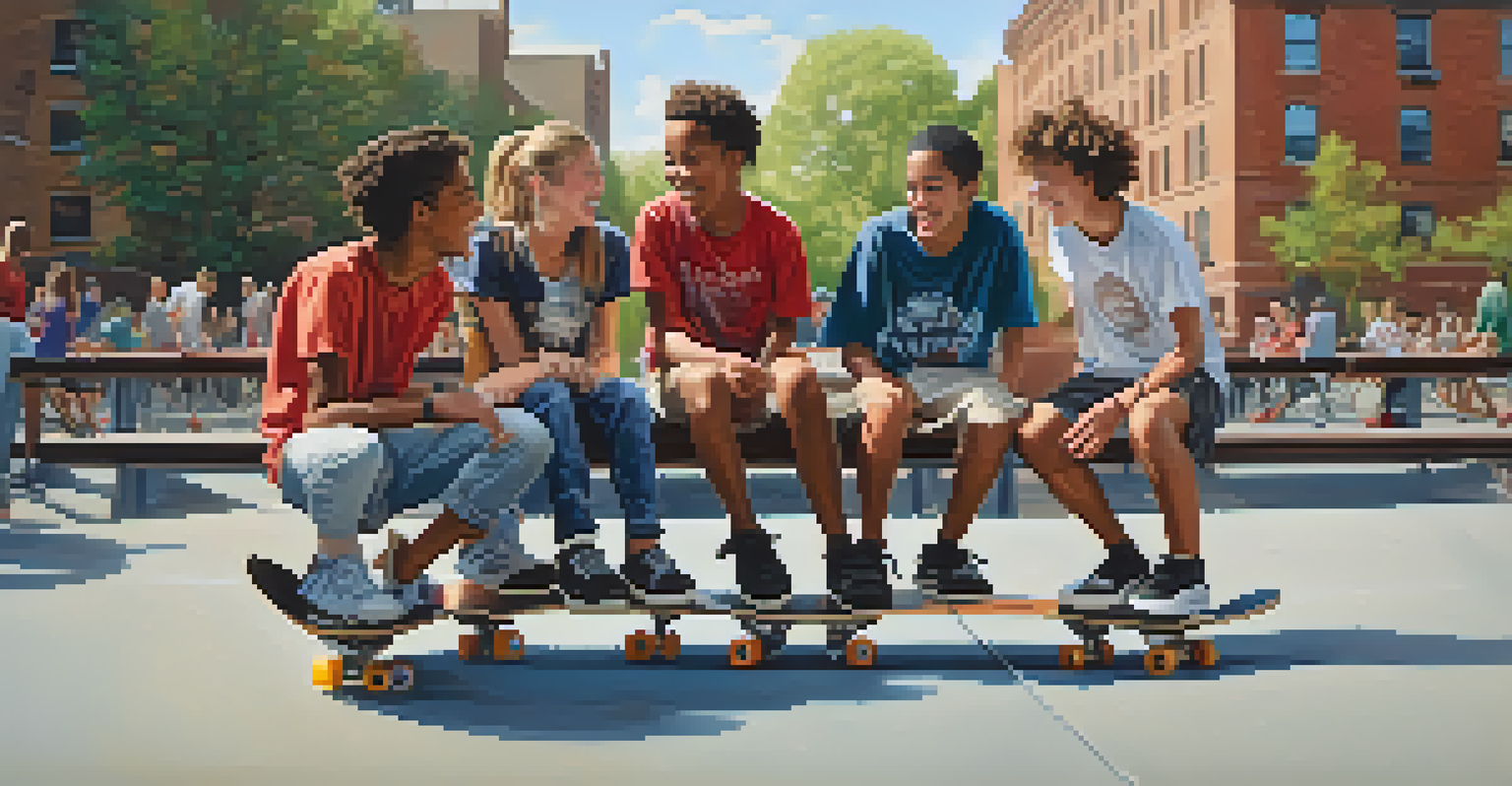The Influence of Skate Culture on NYC Youth Trends Today

The Roots of Skate Culture in New York City
Skate culture in New York City dates back to the 1970s, originating from a desire for freedom and self-expression. Early skaters took to the streets and parks, using their boards as a means to navigate the urban landscape. These pioneers not only created a unique subculture but also laid the groundwork for what would become a global movement. Over the years, NYC has remained a melting pot for diverse skating styles and influences, making it a rich hub for aspiring skaters.
Skateboarding is not just a sport; it's a way of life that fosters creativity and community.
As skateboarding gained popularity, it intertwined with hip-hop, punk rock, and street art, reflecting the vibrant and rebellious spirit of the city. This fusion of cultures has given rise to iconic skating spots like the Brooklyn Banks and the LES Skatepark, where creativity and community thrive. Today, skate culture continues to evolve, but its core values of inclusivity and innovation remain unchanged.
The legacy of early skaters influences today's youth, who often view skateboarding as more than just a sport—it's a lifestyle. Young skaters are not only honing their skills but also embracing the culture's ethos, which promotes individuality and self-discovery. This foundation has allowed NYC's skate scene to flourish and adapt, influencing various aspects of youth culture.
Fashion Trends Driven by Skate Culture
Skate culture has significantly influenced fashion trends among NYC youth, with many adopting styles that reflect their passion for skating. Baggy jeans, graphic tees, and vibrant sneakers are just a few staples that have made their way into everyday wardrobes. Brands like Supreme and Thrasher have become household names, not just in skate circles but in mainstream fashion as well.

The rise of streetwear, deeply rooted in skate culture, has transformed how young people express themselves through clothing. This trend is not just about aesthetics; it’s a statement of identity and belonging. Many teens feel empowered to mix and match styles, creating unique looks that reflect their personalities while also connecting them to the broader skate community.
Skate Culture's Diverse Origins
New York City's skate culture emerged in the 1970s, combining elements of hip-hop, punk rock, and street art to create a unique and evolving community.
Moreover, skate-inspired fashion often bridges the gap between comfort and style, making it appealing to a wide audience. This trend encourages creativity, as young people are inspired to reinvent their looks while showcasing their love for skating. As a result, skate culture continues to shape the fashion landscape in NYC, making it an integral part of the youth identity.
Skateboarding as a Vehicle for Community Engagement
Skateboarding serves as a powerful tool for community engagement, especially among NYC youth. Local skate parks often become safe havens where skaters of all backgrounds come together to share their passion. These spaces foster friendships and encourage collaboration, helping to break down social barriers and promote inclusivity.
The beauty of skate culture is that it brings people together, regardless of their background.
Many community organizations have recognized the potential of skateboarding to unite young people, offering programs that teach skills and provide mentorship. Events like skate competitions and workshops not only showcase talent but also promote positive values such as teamwork and perseverance. This community aspect of skate culture reinforces a sense of belonging and pride among participants.
Furthermore, the rise of skate collectives and advocacy groups has led to increased awareness about the importance of maintaining public skate spaces. These initiatives often involve local youth in decision-making processes, empowering them to take ownership of their environment. In this way, skate culture transcends the sport, creating a lasting impact on community dynamics.
The Role of Social Media in Skate Culture
In today's digital age, social media plays a crucial role in shaping skate culture and connecting NYC youth. Platforms like Instagram and TikTok allow skaters to share videos of their tricks, style, and experiences, reaching audiences far beyond their local neighborhoods. This visibility not only inspires others to join the skating community but also creates a sense of global camaraderie among skaters.
Social media has also democratized the skateboarding scene, enabling anyone with a smartphone to become a content creator. The rise of influencers and skateboarding brands using these platforms to promote their products has transformed how youth engage with skate culture. Young skaters are not just consumers; they are active participants in shaping trends and influencing each other through their online presence.
Fashion Trends from Skateboarding
Skate culture has significantly influenced NYC fashion, promoting styles that reflect individuality and a sense of belonging among youth.
Additionally, social media fosters a platform for discussions around important issues within the skate community, such as inclusivity and representation. This dialogue encourages young skaters to be aware of their impact and to push for positive change within their culture. In this way, social media serves as a powerful tool for both self-expression and community building.
Skateboarding and Mental Health Awareness
Skateboarding is increasingly recognized for its positive effects on mental health, particularly among NYC youth. The act of skating can be a form of therapy, providing an outlet for stress and anxiety. Many young skaters find solace in the rhythm of their boards, allowing them to escape from everyday pressures and channel their emotions into something productive.
Various skate programs are now focusing on mental health awareness, promoting wellbeing alongside skateboarding skills. These initiatives often include workshops that teach young people how to cope with challenges and encourage open discussions about mental health. By combining physical activity with emotional support, these programs provide a holistic approach to youth development.
Moreover, the camaraderie found in skateboarding can help combat feelings of isolation. Skaters often form tight-knit communities where they support each other's mental health journeys, creating a positive environment for growth. In this way, skate culture not only nurtures physical skills but also fosters emotional resilience among NYC's youth.
Influence of Skateboarding on Urban Art
Skate culture has long been intertwined with urban art, making a significant impact on NYC's artistic landscape. The streets serve as canvases for graffiti and murals, often inspired by the vibrant and rebellious spirit of skateboarding. Many young artists draw inspiration from their skate experiences, merging their love for skating with their creative expression.
Skateboard graphics themselves often feature artwork from renowned artists, further blurring the lines between skating and urban art. This collaboration has led to a unique aesthetic that resonates with youth culture, fostering a sense of identity and pride. Events like skate and art exhibitions showcase this intersection, bringing together skaters and artists to celebrate their shared passions.
Skateboarding Fosters Community
Skateboarding serves as a powerful avenue for community engagement, bringing together youth from diverse backgrounds and promoting inclusivity.
As a result, skateboarding has become a catalyst for artistic expression in NYC, encouraging young people to explore their creativity. The ability to customize skateboards with personal artwork has led many to pursue careers in design and illustration, demonstrating the profound influence of skate culture on various creative fields. This relationship continues to thrive, inspiring the next generation of artists and skaters alike.
The Future of Skate Culture in NYC
Looking ahead, the future of skate culture in NYC appears bright and promising. As the sport continues to gain popularity, new skate parks and facilities are being developed to accommodate the growing community. These spaces not only provide opportunities for young skaters to practice their skills but also serve as venues for events that celebrate the culture.
With the increasing recognition of skateboarding as an Olympic sport, there is a renewed interest in the discipline, attracting even more youth to the scene. This mainstream acceptance has the potential to further diversify the skate community, inviting skaters from different backgrounds and skill levels to participate. The inclusivity of skate culture remains a vital aspect as it evolves.

Furthermore, as issues like climate change become more pressing, skaters are also stepping up to advocate for sustainable practices within their community. This awareness is shaping the future of skateboarding in NYC, encouraging young people to not only embrace the sport but also become responsible stewards of their environment. The influence of skate culture on NYC youth trends will undoubtedly continue to grow, adapting to the times while maintaining its core values.